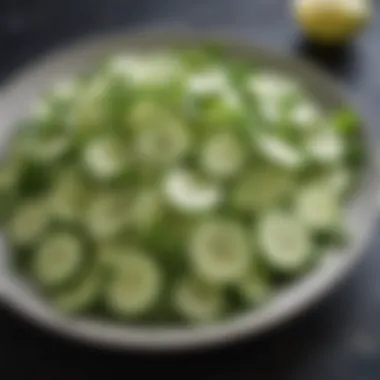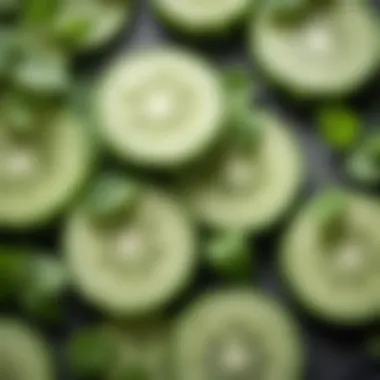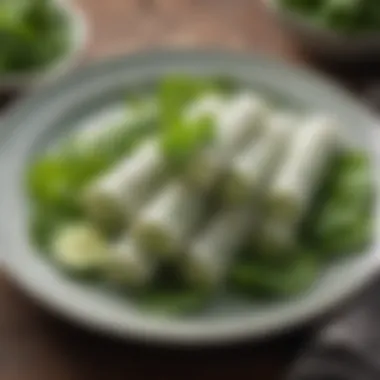Cucumber and Mint: A Culinary Exploration


Intro
Cucumber and mint stand out in the culinary world for their unique qualities. These two ingredients share a refreshing character that elevates flavors in a variety of dishes. Whether used in salads, beverages, or main courses, they have a significant impact.
Historically, cucumber has been cultivated for thousands of years. Its crisp texture and mild taste make it a staple in many cultures. Mint, on the other hand, adds a distinct aromatic note that can brighten any dish. Together, these ingredients are no longer confined to simple salads or garnishes. Their potential extends far beyond these traditional uses.
In this article, we will examine the versatile nature of cucumber and mint. We will explore their nutritional benefits, historical context, and innovative culinary applications. Our goal is to inspire both novice cooks and experienced chefs alike to integrate these ingredients into their cooking routines.
Moreover, we will offer various recipes that highlight the interplay between cucumber and mint. We hope to present an engaging narrative that enlightens readers on how to create tantalizing dishes that showcase the flavors and benefits of these ingredients.
Preface to Cucumber and Mint
Cucumber and mint are two ingredients that have stood the test of time in culinary practices worldwide. Their unique flavor profiles complement each other and enhance a variety of dishes, from salads to beverages. This article aims to illuminate the culinary potential of these fresh ingredients, offering insight into their nutritional benefits, historical significance, and diverse applications in cooking.
The importance of discussing these ingredients goes beyond their taste. Cucumber is known for its high water content, providing hydration and a crisp texture. Mint, on the other hand, adds a refreshing, aromatic quality that can elevate simple dishes into extraordinary ones. Together, they create a balance that caters to both palates seeking refreshment and those craving depth of flavor.
Moreover, understanding how to use cucumber and mint effectively can open up a world of culinary possibilities for both novice cooks and seasoned chefs. By exploring various preparation techniques, recipe ideas, and cultural variations, we can inspire creativity in the kitchen. The goal is to not only introduce these ingredients but also encourage experimentation that respects their inherent qualities.
The harmonious interplay between cucumber's crispness and mint's zest can significantly enhance the dining experience, making the exploration of these ingredients both relevant and timely.
Overview of Ingredients
Cucumber, scientifically known as Cucumis sativus, belongs to the gourd family. It is primarily composed of water, making it an excellent choice for boosting hydration in warmer climates. Fresh cucumbers can be consumed raw, pickled, or cooked, and they are often valued for their mild flavor, which allows them to blend seamlessly into various dishes.
Mint, on the other hand, refers to several species of plants in the Mentha genus, with Mentha spicata (spearmint) and Mentha piperita (peppermint) being the most widely used for culinary purposes. Mint's flavor is sharp and cooling, delivering a burst of freshness that can uplift traditional recipes. It can be used fresh, dried, or as an oil, making it a versatile herb in cooking.
Incorporating these ingredients into meals not only offers flavor enhancement but also contributes to healthier eating. Both cucumber and mint are low in calories and high in essential nutrients, which makes them desirable for many dieters and health-conscious individuals. Therefore, taking the time to understand cucumber and mint in-depth serves both culinary and nutritional purposes.
Historical Significance
The historical significance of cucumber and mint cannot be overstated when considering their roles in culinary traditions, medicinal properties, and cultural symbolism. Both ingredients have been used for centuries, and their influences can be seen across various civilizations. Understanding this background provides a context for their contemporary uses, enriching the culinary experience.
Origins of Cucumber
Cucumber has a rich history that dates back thousands of years. The first records of cucumber cultivation appear in ancient India, where it was likely cultivated as early as 4000 BCE. It later spread to other regions, becoming a staple in the diets of Egyptians, Greeks, and Romans. In ancient Rome, Julius Caesar is said to have enjoyed cucumbers regularly, appreciating their refreshing qualities. This vegetable was not just valued for its taste but also for its health benefits.
The spread of cucumber through trade routes contributed to its integration into various cuisines. For instance, in Middle Eastern cultures, cucumber is often utilized in salads and cold dishes, showcasing its textural contrast and hydrating properties. Its use has evolved, but the core purpose remains - to provide a light, crisp addition to diverse recipes.
Roots of Mint in Culinary Practices
Mint's history in culinary practices goes hand-in-hand with its medicinal uses. The use of mint can be traced back to ancient Egypt, where it was employed as a flavoring, a digestive aid, and even as an aromatic in burial rituals. This herb continued to thrive in various cultures, becoming integral to Greek and Roman cuisines.
Mint is celebrated for its refreshing flavor and cooling effects. The mint family, which includes spearmint and peppermint, has been utilized in beverages, sauces, and main dishes. In Islamic culture, mint is often included in traditional dishes, highlighting its versatility. Furthermore, its medicinal properties—such as its role in aiding digestion—have ensured its ongoing importance in culinary traditions.
Today, both cucumber and mint endure as vibrant ingredients, thanks to their historical roots and enduring appeal. They not only enhance flavors and provide nutritional value but also remind us of the rich traditions from which they arose.
Nutritional Benefits
Understanding the nutritional benefits of cucumber and mint is essential in recognizing their role in modern cuisine. These ingredients are not just flavorful additions; they contribute significantly to health and well-being. This section will elaborate on the individual health benefits of cucumber and mint, further enriching their culinary potential.
Health Benefits of Cucumber


Cucumber offers numerous health advantages, making it a worthwhile ingredient in any diet. It is mainly composed of water, about 95%, which helps in hydration. This makes cucumbers a fantastic addition to salads and refreshing beverages. Furthermore, cucumbers are low in calories, making them an excellent choice for those monitoring their weight. Additionally, cucumbers contain essential nutrients such as vitamin K, which is vital for bone health and blood clotting.
The presence of antioxidants, such as flavonoids and tannins, helps combat oxidative stress. Consuming cucumbers may also aid in digestion due to their high water content and fiber, particularly in the skin. Studies suggest that the presence of silica in cucumbers can promote skin health, enhancing its appearance and elasticity. Overall, incorporating cucumber into meals not only adds a crunchy texture but also delivers a range of health benefits.
Nutritional Value of Mint
Mint, often overlooked, packs a punch in nutritional value. This herb is not only aromatic but also rich in essential nutrients. It is an excellent source of vitamin A, which is crucial for maintaining healthy vision, skin, and immune function. Mint leaves are also known for their high levels of antioxidants and anti-inflammatory properties. These attributes make mint an ideal ingredient for enhancing flavor while providing health benefits simultaneously.
Moreover, mint may assist in digestion. Traditional practices have long used mint to alleviate digestive discomfort and to stimulate digestive enzymes. The refreshing flavor of mint doesn't just elevate dishes; it can also promote a feeling of well-being. The menthol component in mint leaves can have a cooling effect, providing relief from nausea or headaches.
By understanding the nutritional aspects of these two ingredients, cooks can make informed choices in their culinary creations. Not only do cucumber and mint improve the taste of dishes, but they also contribute positively to health—making them indispensable in both traditional and modern cooking.
Flavor Profile and Pairings
Understanding the flavor profile of cucumber and mint is crucial for enhancing culinary creativity. These ingredients not only add flavor but also elevate the overall experience of a dish. Pairing cucumber with mint can create refreshing combinations that stimulate the palate. Moreover, grasping the nuances of their flavors can assist in achieving harmony across various dishes.
Understanding Cucumber’s Flavor
Cucumber has a crisp, watery texture with a subtle taste. Its flavor is often described as mild and refreshing, making it a versatile ingredient in many culinary applications. The high water content, around ninety-six percent, contributes to its lightness and makes cucumber an ideal base for salads and cold dishes. Its taste is best characterized as subtly sweet and herbaceous. This flavor can sometimes vary depending on the variety of cucumber. For example, English cucumbers tend to have a sweeter flavor compared to the slightly bitter skin of the standard American cucumber.
In cooking, cucumber can be served raw or cooked, though it is predominantly featured in raw applications. When complementing other flavors, cucumbers work well with both acidic ingredients like vinegar and lemon juice and richer elements such as yogurt or avocado. Their mildness allows them to absorb surrounding flavors, enhancing rather than overpowering a dish.
The Impact of Mint on Flavor Combinations
Mint brings an invigorating and unique flavor profile to dishes. Its aromatic qualities are unmistakable, often described as cool and herbaceous. The two prominent types of mint used in cooking are peppermint and spearmint. Spearmint has a sweeter profile, while peppermint tends to have a more intense, robust flavor. Understanding these distinctions can greatly influence how mint is used in various recipes.
When mint is added to dishes, it can elevate the sensory experience. The coolness of mint can balance or contrast with spicy, rich, or fatty foods. This versatility makes mint a favored pairing with cucumber. For example, in a salad, the combination of cucumber and mint creates a refreshing effect that enhances the overall flavor.
Mint can also play a vital role in beverages and desserts. The herb lends a refreshing note to drinks, such as mojitos or infused waters. Pairing mint with fruits like watermelon and citrus can also bring a new dimension to fruit salads or desserts.
"Cucumber and mint not only complement each other but also offer an authentic flavor experience that enhances various culinary creations."
Culinary Techniques
Culinary techniques are essential for maximizing the full potential of ingredients, particularly with versatile items like cucumber and mint. Understanding the right methods to prepare these ingredients can greatly impact the flavor and texture of a dish. Effective culinary techniques can enhance the overall dining experience, making food not just nourishing but also enjoyable to eat. From slicing to infusing, the way one handles cucumber and mint can transform a simple meal into an extraordinary one.
Preparation Methods for Cucumber
Slicing
Slicing is a fundamental preparation method used for cucumber that highlights its crisp texture. Thin slices of cucumber often serve as fresh toppings in salads or as bases for canapés. The key characteristic of slicing is its simplicity; this method allows the eature of the cucumber to shine without overwhelming the dish with excessive processing.
The unique feature of slicing is that it can be easily adjusted to cater to different textures desired. For instance, thicker slices can be used for a more substantial crunch compared to thinner slices, which would contribute to a milder flavor profile because of increased cucumber surface area. One disadvantage might include the limited variety in presentation, as different dishes could benefit from a more diverse shape.
Dicing
Dicing involves cutting cucumbers into small, uniform cubes. This method enhances the versatility of cucumber in various dishes, as it allows for even distribution of cucumber's flavor in salads, salsas, or cold dishes. The uniformity of dicing is a major advantage. It ensures that each bite contains an equal amount of flavor.
One key characteristic of dicing is that it presents a cohesive appearance, which is appealing in dishes like tabbouleh or Greek salad. However, the preparation time can be a drawback; dicing takes more effort than simply slicing and may require a bit of skill to achieve uniform sizes.
Spiralizing


Spiralizing cucumber transforms it into long, curly strands, introducing a playful aspect to dish presentation. This method is particularly popular in salads or as a low-carb alternative to pasta. Spiralized cucumbers maintain a crunchy texture while providing a unique aesthetic.
The main characteristic of spiralizing is its ability to bring creativity to plating. It adds volume to dishes without adding significant calories. However, a downside of this method is that spiralized cucumbers can sometimes release excess water, potentially making certain dishes soggy if not consumed quickly.
Using Fresh Mint Effectively
Chopping
Chopping fresh mint allows for a boost in flavor across culinary applications. The chopping method releases essential oils from the mint leaves, intensifying its aroma and taste. This method is popular because it maximizes flavor infusion in dishes.
The key characteristic of chopping is its efficiency; it allows the herb to be incorporated easily into dressings, marinades, or as a garnish. One advantage is that the fresh punch of flavor can elevate a dish significantly. However, care must be taken to avoid bruising the leaves too much, which can lead to a bitter taste.
Muddling
Muddling is a technique often employed in cocktails, where the aim is to release flavor from fresh mint leaves. By lightly crushing the leaves, a rich aroma infuses drinks such as mojitos and mint juleps. This method is integral for drinks but can also be used in dips or sauces.
The uniqueness of muddling lies in its sensory appeal. As the leaves are pressed, the aromatic oils disperse, greatly enhancing the overall experience. While effective, the disadvantage is that if done improperly, muddling can result in bitter flavors, steering the taste away from the intended refreshing impact.
Infusing
Infusing fresh mint involves steeping the leaves in liquids, allowing their flavors to permeate. This technique is widely used in both sweet and savory dishes, adding depth to sauces, teas, and syrups. Infusion is a popular choice, as it enables a concentrated flavor with minimal preparation.
The key characteristic of infusing is the subtlety it brings to dishes, where mint's flavor can be present without overpowering other elements. However, a drawback is the time it may take for flavors to develop, as infusing sometimes requires patience to achieve the desired taste profile.
"The way ingredients are prepared can transform the dining experience and uncover hidden flavors."
By mastering these culinary techniques, cooks can elevate cucumber and mint from mere ingredients to stars of their culinary creations.
Recipe Ideas Incorporating Cucumber and Mint
The exploration of recipe ideas that incorporate cucumber and mint highlights a captivating aspect of culinary creativity. Both ingredients possess refreshing qualities that can elevate dishes across various categories. Discussing these recipes is not merely about flavor; it’s about how these vibrant components can transform ordinary meals into extraordinary experiences. The benefits are numerous, from enhancing visual appeal to introducing unique flavor profiles that stimulate the palate.
Salads and Dressings
Salads are a natural choice for including cucumber and mint. Cucumber adds a crisp texture, while mint introduces a burst of freshness. Combining these two can yield salads that are not only light but also invigorating. A simple cucumber and mint salad with olive oil, lemon, salt, and pepper may sound basic, but its brightness can revitalize any meal.
Consider pairing sliced cucumber with chunks of ripe tomatoes, red onion, and fresh mint to create a colorful salad. Adding a drizzle of balsamic reduction enhances the flavors substantially. Dressings that incorporate mint, such as a yogurt mint dressing, can also provide a creamy contrast to the crunchy elements of the dish. This type of combination showcases how versatile salads with cucumber and mint can be.
Beverages and Infusions
The incorporation of cucumber and mint into beverages opens up numerous possibilities. Infusing water with cucumber and mint is a refreshing option, especially during warm months. The coolness of cucumber paired with mint can create a hydrating drink that feels both chic and revitalizing. This beverage complements any casual or formal setting.
Furthermore, cucumber and mint blend beautifully in cocktails. The Mojito, a classic rum drink, emphasizes the refreshing qualities of mint while using muddled cucumber can amplify its flavor. Creating your own infused beverages at home allows for customization, enabling the incorporation of other fruits or herbs to enhance the drinking experience. Using these ingredients in beverages elevates hydration to an art form.
Soups and Appetizers
Cucumber and mint can also serve as key ingredients in soups and appetizers. A chilled cucumber-mint soup, made with yogurt or coconut milk, offers a soothing and light starter. The creaminess of yogurt combined with the freshness of mint creates a harmonious balance. This dish is particularly pleasing during summer months.
For appetizers, cucumber slices topped with a mint-infused cream cheese spread or hummus can serve as delightful bites. They are perfect for gatherings, offering a fresh alternative to heavier options. Presenting these combinations in creative ways can leave a lasting impression on guests.
Main Dishes Featuring Cucumber and Mint


In main dishes, cucumber and mint can serve various purposes, enhancing both flavor and presentation. Grilled chicken or fish can benefit from a cucumber and mint salsa, which balances the richness of the proteins. The refreshing nature of the salsa contrasts with grilled items and helps cut through the fat, making the meal lighter.
Additionally, Mediterranean dishes often feature creative uses of these ingredients. A couscous salad with cucumber, mint, and feta cheese can become a filling side or a main dish in itself. Here, the mint contributes a fragrant note, marrying well with the other ingredients. Incorporating these elements in main dishes adds layers to the culinary experience, showcasing the adaptability of cucumber and mint.
Cultural Variations
Culinary traditions are deeply influenced by geography, climate, and cultural exchanges throughout history. The use of cucumber and mint is no exception. These ingredients take on distinctive roles in various cuisines, revealing a rich tapestry of flavors and techniques. Understanding these cultural variations enhances one's appreciation of the diversity in culinary practices. This section will explore how cucumber and mint are integrated into Middle Eastern and Asian cuisines, highlighting their unique applications and significance.
Cucumber and Mint in Middle Eastern Cuisine
Middle Eastern cuisine showcases cucumber and mint in various refreshing dishes. Their pairing is especially cherished due to the region's warm climate, where cooling flavors are essential. Cucumber is often used in salads, such as the classic Fattoush, which blends several vegetables with crisp lettuce, tomatoes, and herbs, offering a light yet flavorful option. Mint, on the other hand, lends an aromatic quality that elevates dishes.
Labneh, a popular strained yogurt, benefits from the addition of finely chopped cucumber and mint. The creamy consistency of labneh pairs beautifully with the crunch of cucumber and the fresh note of mint. Additionally, mint is infused in drinks like Ayran, providing a unique spin to this traditional yogurt beverage. The cultural significance of these combinations reflects the region's emphasis on balance and harmony in flavors.
Use in Asian Culinary Traditions
In Asian culinary practices, cucumber and mint are used creatively and variably. Cucumber is a staple in salads, often feature in Vietnamese Gỏi, which blends fresh vegetables set against a backdrop of herbs and protein. The addition of mint adds a burst of flavor that distinguishes this salad from its Western counterparts.
Mint also finds its way into drinks like the Thai Nam Manao, a refreshing lime-infused beverage that incorporates fresh mint, enhancing its aromatic depth. Furthermore, in dishes like Indian Raita, cucumber and mint work together to create a cooling accompaniment to spicy meals. This synergy illustrates the versatility of cucumber and mint across different cultures, supporting the idea that both ingredients are adaptable yet essential in enhancing many dishes.
The versatility of cucumber and mint showcases their essential roles in various culinary traditions, underlining how regional flavors and practices can elevate simple ingredients into memorable dishes.
In summary, the incorporation of cucumber and mint in culinary practices varies by culture, reflecting unique preferences and ingredients available. Understanding these variations not only broadens one's culinary skills but enriches the dining experience by connecting food to its cultural roots.
Preservation and Storage
Understanding the best practices for preservation and storage is essential when it comes to maximizing the longevity and quality of cucumber and mint. Freshness is a key factor in maintaining their taste and nutritional value. Proper handling and storage prevent spoilage, help reduce waste, and ensure that these ingredients remain a delightful addition to various dishes.
In this section, we will explore effective strategies for storing cucumbers and preserving fresh mint. Well-stored cucumbers retain their crisp texture, while properly preserved mint can provide fresh flavors even when out of season.
Best Practices for Storing Cucumber
Cucumbers have a high-water content, which makes them prone to spoilage if not stored correctly. Here are some best practices:
- Refrigeration: Cucumbers should be kept in the crisper drawer of the refrigerator. The cooler temperature slows down the ripening process and keeps them fresh longer.
- Humidity Control: Aim for a humid environment; placing cucumbers in a perforated plastic bag helps maintain humidity while allowing some air circulation.
- Avoiding Pressure: When storing cucumbers, minimize pressure on them. Do not stack heavy items on top, as this can cause bruising and lead to quicker spoilage.
- Consume Quickly: Ideally, cucumbers should be consumed within one week of purchase for optimal taste and texture. These simple steps can extend the life of this refreshing vegetable.
How to Preserve Fresh Mint
Preserving fresh mint allows you to enjoy its invigorating flavor long after the herb is harvested. Here are several methods for doing so:
- Freezing: One of the most effective ways to preserve mint is by freezing it. Wash and dry the leaves, then place them in ice cube trays filled with water or olive oil. Once frozen, transfer the cubes to a resealable bag. This method captures the essence of mint and can be used later in cooking or beverages.
- Drying: Hanging mint stems upside down in a dry, dark, and well-ventilated area helps to dry the leaves. Once dried, the leaves can be crushed and stored in an airtight container. This allows for easy use in seasoning and teas.
- Chopping and Storing: If you prefer fresh mint taste, chop the leaves finely and mix them with a small amount of olive oil before placing them in a container. This method helps prevent browning and keeps the herb fresh for a longer period when stored in the refrigerator.
Proper storage and preservation techniques not only enhance flavors but also ensure that cucumbers and mint remain staples in the kitchen. By taking a little time to learn these methods, cooks can enjoy these vibrant ingredients year-round.
Culmination
The importance of this conclusion within the article cannot be overstated. Cucumber and mint emerge not only as ingredients but as pillars of culinary creativity. Their refreshing qualities and vibrant flavors make them indispensable in diverse dishes. By summarizing the benefits and applications discussed, readers grasp the full extent of their potential.
The Enduring Appeal of Cucumber and Mint
Cucumber and mint have a lasting appeal that resonates across cultures and cuisines. Their crisp texture and cooling flavor from cucumber combine seamlessly with the aromatic, invigorating profile of mint. This combination promotes a sense of well-being and freshness, which is particularly valuable in contemporary food trends focused on health and vibrancy.
One significant aspect to consider is how these ingredients elevate even the simplest dishes. The natural hydrating properties of cucumber stand out during hot weather, while mint infuses a bright note that can transform ordinary meals into delightful experiences.
Moreover, cucumber and mint are versatile in preparation. From salads to beverages and soups, their uses span an impressive range of culinary styles. Each application showcases their adaptability, attracting attention from experimenters in both home and professional kitchens.
The blending of cucumber and mint exemplifies a harmonious balance. This is not just about taste; it reflects cultural traditions and modern innovations in gastronomy.















